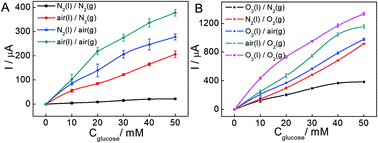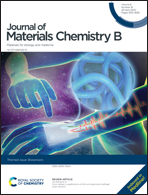A single-liquid miniature biofuel cell with boosting power density via gas diffusion bioelectrodes†
Abstract
The low solubility of gas molecules in aqueous solutions has limited the power density output of enzymatic biofuel cells. Herein, a single-liquid miniature glucose–O2 fuel cell was constructed by using gas diffusion electrodes, which were prepared by immobilizing glucose oxidase (GOx) or laccase (Lac) modified on a porous structured carbon paper (CP). Due to the fast and direct O2 diffusion from air to the active sites of the immobilized enzyme through the pores of the CP anode/cathode with controlled wettability, the maximum power output densities dramatically increased to 9.64 μW cm−2 at 0.43 V and 53.0 μW cm−2 at 0.45 V for the cell in 5 mM glucose and after exposing the cell to air or O2 atmosphere, respectively. Interestingly, the resulting single-liquid cell could harvest power from human serum operating at a maximum power density of 49.0 μW cm−2 at 0.2 V. The biofuel cell fabricated by the gas diffusion electrodes displayed advantages such as high output power density, low cost and high ‘on-chip’ integrability and miniaturization, which suggest its great potential for implantable self-powered sensors and for many future applications.

- This article is part of the themed collection: Biosensors


 Please wait while we load your content...
Please wait while we load your content...